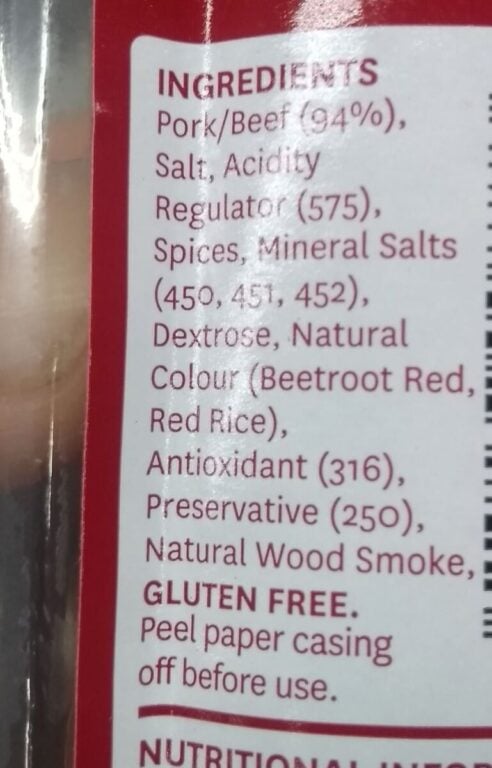Table of Contents
For decades, immersed in studying, working, learning, and teaching in the craft of meat curing, now sharing his passion with you through eat cured meat online resource.
Whether salami has carbohydrates isn’t a straightforward yes or no answer. This comes from someone who makes salami at home and has studied salami for decades and visited many commercial salami producers.
In short, variations exist based on country and brand; please see the ranges below. Then, I will get into more detail. Since, salami can be defined in many different ways.
Many commercially made salami contain carbohydrates in the form of starch or sugars, while dry-cured traditional salami often does not.
“Cotto” below is “Cooked” in Italian. The other salami is dry-cured, often fermented.
Here is a table based on 100 grams with links to scientific authority sites where this was confirmed.
| Salami Type | Carbohydrates (g) | Sugar (g) |
|---|---|---|
| Hard Salami | 0-2.5 | 0-0.9 |
| Genoa Salami | 0-2.8 | 0-2.5 |
| Milano Salami | 0.9-2.5 | 0-2.4 |
| Soppressata | 0-2.3 | 0-0.9 |
| Pepperoni | 0-4.0 | 0-2.0 |
| Italian Dry Salami | 0-3.0 | 0-0.9 |
| Cotto Salami | 0-3.2 | 0-0.9 |
Note:
- Nutritional values are given per 100g and are approximate averages.
- Actual values vary between brands, so refer to the product labels for precise information.
As someone with intimate knowledge of what goes into salami, I can say that quality artisanal salami that takes a few months to dry is often fermented. This is the tang sometimes you get in the mouth; it’s about pH reduction, an increase in acidity to help preservation.
Simple sugars like dextrose are often added to ‘feed’ the starter culture for kickstarting fermentation.
Fructose and Sucrose from vegetables, or in a derivative form can also be used to feed cultures for fermentation.
The beneficial cultures consume these sugars and produce lactic acid.
The only one I would consider adding is dextrose or an alternative form of sugar (which is a carbohydrate). It would be to balance out other more intense flavors.

You wouldn’t use any additional carbohydrates for genuine dry-cured salami. But it’s a rather different goal for most salamis produced in mass production.
So, I’ll give you a quick answer, and then, if you’re interested, I’ll dive into some of the other ingredients and unknowns surrounding the infamous salami.
Salamis produced world-wide vary dramatically in quality, and the methods of production vary greatly, too.
Gerhard Feiner, in Salami –
Commercial salami is all about maximizing profit, in general. Only a few producers I’ve studied that produce over 1,000pds a day/500kg have quality as a top priority.
The anomaly would be classic European manufacturers in Italy, Spain, etc.
Where the food culture demands a level of quality and passion, or the product does not sell.
Additives include soy products, soy proteins, gums, extenders, whey protein, flour, or starches – some of which are carbohydrates.
At a local supermarket, here is a picture of the additional additives:

Whether the salami has been properly fermented, which is part of a traditional salami process, can tell whether they may have more carbs.
Basically, the acidity when fermenting inside the salami increases the acids, lowering the pH. Lowering the water content or water activity as well inside the salami (which intensifies flavor and preserves it once the cured salami has lost about 35-40% of this weight) – this is traditionally dry-cured salami.
To give you an idea of contrast, some commercially produced salami take one day to make using heat, additives, rapid acidification, and other modern food production techniques.
This contrasts with dry-cured salami (cut and whole salami storage is also different), which involves curing, fermentation often, and a drying stage. It can take 1 to 4 months to make.
What is Salami Made Of?

If you are talking about dry-cured quality, it should be made of :
- Salt
- Meat
- Fat
- Spices
- (Nitrates Generally)
- Starter Cultures
- Simple Sugars (Dextrose for Fermentation)
Where do the Carbohydrates in Salami Come From?
What Most Commerical Salami (Supermarket quality) is made of:
The Above ingredients plus often these below:
- Cellulose = Carbohydrate
- Starch = Carbohydrate
- Modified Starch = Carbohydrate
- Sugar (Dextrose for example) = Carbohydrate
Many of these ingredients play a role in making the product more durable and providing better business outcomes.
I’m not going to get into the details of the ethics or what I think about adding these ingredients.
Fibers are another way of making that salami faster in a factory; fiber is often a form of carbohydrate; read the ingredients and nutritional information to check.
Fibers are a recent addition to salami to accelerate the speed of drying as well as reducing the Aw (water activity) within a salami product, and powdered cellulose was the first type of fiber applied because it is one of the most abundant organic materials on earth.
Salami – Science Direct
Starch & Modified Starch in Cheap Salami
Here is why they use these products inside the salami.
Improved Texture
It’s like having tiny little pockets of moisture, so you have a semi-firm, hard piece of meat with built-in moisture.
Mouth feel is improved.
Profit from the Product
A major reason for having carbohydrates in the salami is to avoid the cost of more expensive meat or fat.
Certain additives allow more water to bind with meat protein. Meaning, less meat more water equates to more profit.
As a Fat Substitute
Carbohydrates are used as a fat substitute. Certain modified starches are a fat substitute for “low-fat” versions of traditionally made, more fatty products. So the companies can label the hard salami as having “reduced fat,” and to replace it, they use carbohydrates.
If you want reduced-fat salami, my advice is to just not eat it. The fat is part of the product.
Increase Shelf Life
Certain effects of using some of these carbohydrate-based products exist, and of course, they increase the shelf life of the product in the same state. Therefore, it comes back to the profitability drive.
Is Salami Keto Friendly?
Yes.
If you’re talking about pure proteins, quality salami seems keto-friendly (I wrote about salami and keto in detail here). If you want to read a bit more on the topic I wrote a post to answer the question from the community.
I wrote a post on cured meat and keto friendliness here.
References
https://www.nutritionvalue.org/Salami%2C_pork%2C_dry_or_hard_nutritional_value.html?size=100+g
Although the below link goes to a range of sausages/salami. I note, they have 6g per 100g for salami. I have not come across a salami with this level of carbs.
https://www.healthline.com/nutrition/carbs-in-sausage#carb-content

